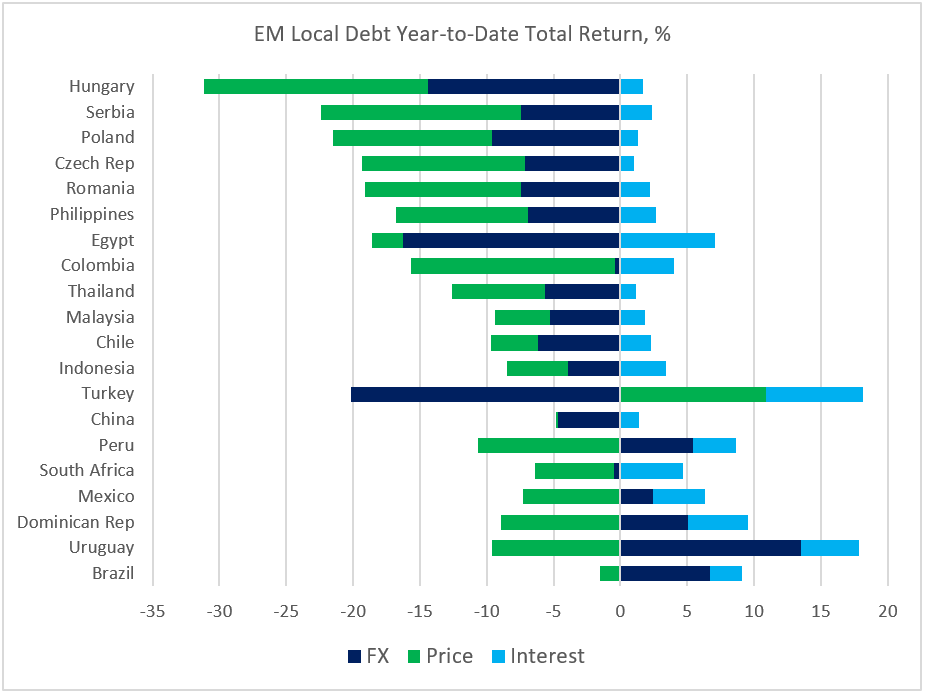By Natalia Gurushina
Chief Economist, Emerging Markets Fixed Income
EM Local Debt Performance
Surging global inflation and elusive inflation peaks have not been kind to emerging markets (EM) local rates so far this year. But – as the chart below shows – currency dynamics can make a big difference for EM local debt’s total return. Central bank credibility and the timely/aggressive policy response gave a much needed boost to the South African rand and LATAM FX. The question is whether a growing risk of recession will change the playing field in the second half of the year. Very weak consumer confidence in parts of Europe, below-consensus activity surveys in developed markets (DM) and today’s downward revision of Q1 GDP in the U.S. (especially private consumption) suggest that this risk might not be fully priced in by the market.
EM Growth Prospects
As regards EM local debt year-to-date outperformers, the 2022 growth outlook for LATAM has actually been upgraded a bit after hitting the bottom in March-April. The tightening cycle in the region has further to run – which means restrictive policy stance – as inflation is high and well above the target. However, aggressive frontloading should be allow to proceed at a slower pace (of rate hikes) going forward, with a prospect of eventual rate cuts later in 2023. The growth newsflow in South Africa is more concerning though. First, the central bank is a latecomer to the EM tightening cycle and might need to step up rate hikes to bring inflation back to the target range (headline inflation escaped last month). Today’s comments by Governor Lesetja Kganyago about a potential 50bps hike in July were deemed insufficiently hawkish by the market. Second, the wage talks at the country’s power utility, Eskom, resulted in another wave of load-shedding and blackouts. Finally, consumer confidence posted a big drop in Q2 – to the levels last seen in the early-1990s (with the exception of the pandemic).
China Slowdown
The next batch of China’s domestic activity gauges – out this evening – can be an important catalyst one way or another. The market reacted positively to changes in the quarantine rules, and the consensus also expects that both the manufacturing and services PMIs (Purchasing Managers Indices) flip into expansion zone in June. China’s 2022 GDP forecast has been cut again this morning (to 4.13%), but if June’s PMIs do not disappoint, it can mark the lowest point in the current cycle. Stay tuned!
Chart at a Glance: EM Local Debt Performance – Not A Monolith

Source: Bloomberg LP (J.P. Morgan GBI-EM Global Diversified Index)
Originally published by VanEck on 29 June 2022.
For more news, information, and strategy, visit the Beyond Basic Beta Channel.
PMI – Purchasing Managers’ Index: economic indicators derived from monthly surveys of private sector companies. A reading above 50 indicates expansion, and a reading below 50 indicates contraction; ISM – Institute for Supply Management PMI: ISM releases an index based on more than 400 purchasing and supply managers surveys; both in the manufacturing and non-manufacturing industries; CPI – Consumer Price Index: an index of the variation in prices paid by typical consumers for retail goods and other items; PPI – Producer Price Index: a family of indexes that measures the average change in selling prices received by domestic producers of goods and services over time; PCE inflation – Personal Consumption Expenditures Price Index: one measure of U.S. inflation, tracking the change in prices of goods and services purchased by consumers throughout the economy; MSCI – Morgan Stanley Capital International: an American provider of equity, fixed income, hedge fund stock market indexes, and equity portfolio analysis tools; VIX – CBOE Volatility Index: an index created by the Chicago Board Options Exchange (CBOE), which shows the market’s expectation of 30-day volatility. It is constructed using the implied volatilities on S&P 500 index options.; GBI-EM – JP Morgan’s Government Bond Index – Emerging Markets: comprehensive emerging market debt benchmarks that track local currency bonds issued by Emerging market governments; EMBI – JP Morgan’s Emerging Market Bond Index: JP Morgan’s index of dollar-denominated sovereign bonds issued by a selection of emerging market countries; EMBIG – JP Morgan’s Emerging Market Bond Index Global: tracks total returns for traded external debt instruments in emerging markets.
The information presented does not involve the rendering of personalized investment, financial, legal, or tax advice. This is not an offer to buy or sell, or a solicitation of any offer to buy or sell any of the securities mentioned herein. Certain statements contained herein may constitute projections, forecasts and other forward looking statements, which do not reflect actual results. Certain information may be provided by third-party sources and, although believed to be reliable, it has not been independently verified and its accuracy or completeness cannot be guaranteed. Any opinions, projections, forecasts, and forward-looking statements presented herein are valid as the date of this communication and are subject to change. The information herein represents the opinion of the author(s), but not necessarily those of VanEck.
Investing in international markets carries risks such as currency fluctuation, regulatory risks, economic and political instability. Emerging markets involve heightened risks related to the same factors as well as increased volatility, lower trading volume, and less liquidity. Emerging markets can have greater custodial and operational risks, and less developed legal and accounting systems than developed markets.
All investing is subject to risk, including the possible loss of the money you invest. As with any investment strategy, there is no guarantee that investment objectives will be met and investors may lose money. Diversification does not ensure a profit or protect against a loss in a declining market. Past performance is no guarantee of future performance.







